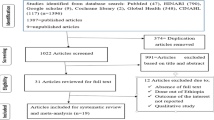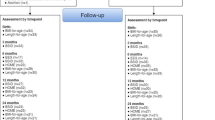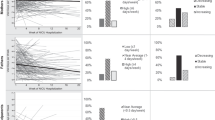Abstract
Objective
To examine low birthweight and preterm birth of second children born to home-visited first-time mothers.
Subjects
Women were previously recruited for a randomized controlled trial of the home visiting model disseminated as Nurse-Family Partnership. 512 of these women had second children within 18 years of the first child’s birth, and were included in our sample.
Results
The intervention was associated with a lower likelihood of low birthweight for second children (odds ratio: 0.51, 95% CI: 0.27, 0.97), an effect apparent only if the first-born had low birthweight and mediated by close birth spacing. These moderation and mediation patterns were similar in the preterm birth outcome.
Conclusion
A home visiting program provided for first-born children reduced low birthweight for second-born children, if the first-born had low birthweight. This finding implies a broader impact than previously documented, because few studies have included these second children.
This is a preview of subscription content, access via your institution
Access options
Subscribe to this journal
Receive 12 print issues and online access
$259.00 per year
only $21.58 per issue
Buy this article
- Purchase on Springer Link
- Instant access to full article PDF
Prices may be subject to local taxes which are calculated during checkout


Similar content being viewed by others
References
Class QA, Rickert ME, Lichtenstein P, D’Onofrio BM. Birth weight, physical morbidity, and mortality: a population-based sibling-comparison study. Am J Epidemiol. 2014;179:550–8.
Johnson RC, Schoeni RF. Early-life origins of adult disease: national longitudinal population-based study of the United States. Am J Public Health. 2011;101:2317–24.
Wadhwa PD, Buss C, Entringer S, Swanson JM. Developmental origins of health and disease: brief history of the approach and current focus on epigenetic mechanisms. Semin Reprod Med. 2009;27:358–68.
Tekola-Ayele F, Workalemahu T, Amare AT. High burden of birthweight-lowering genetic variants in Africans and Asians. BMC Med 2018;16:70.
King K, Murphy S, Hoyo C. Epigenetic regulation of Newborns’ imprinted genes related to gestational growth: patterning by parental race/ethnicity and maternal socioeconomic status. J Epidemiol Commun H. 2015;69:639–47.
Behrman RE, Butler AS. Preterm birth: Causes, consequences, and prevention. Washington, DC: National Academy Press; 2007.
Frey HA, Klebanoff MA. The epidemiology, etiology, and costs of preterm birth. Semin Fetal Neonat M. 2016;21:68–73.
Heerwagen MJR, Miller MR, Barbour LA, Friedman JE. Maternal obesity and fetal metabolic programming: a fertile epigenetic soil. Am J Physiol-Reg I. 2010;299:R711–R722.
Lee E, Mitchell-Herzfeld SD, Lowenfels AA, Greene R, Dorabawila V, DuMont KA. Reducing low birth weight through home visitation: a randomized controlled trial. Am J Prev Med. 2009;36:154–60.
Roman L, Raffo JE, Zhu Q, Meghea CI. A statewide Medicaid enhanced prenatal care program: impact on birth outcomes. JAMA Pediatr. 2014;168:220–7.
Shah MK, Austin KR. Do home visiting services received during pregnancy improve birth outcomes? Findings from Virginia PRAMS 2007–8. Public Health Nurs. 2014;31:405–13.
Robling M, Bekkers MJ, Bell K, Butler CC, Cannings-John R, Channon S, et al. Effectiveness of a nurse-led intensive home-visitation programme for first-time teenage mothers (Building Blocks): a pragmatic randomised controlled trial. Lancet. 2016;387:146–55.
Peacock S, Konrad S, Watson E, Nickel D, Muhajarine N. Effectiveness of home visiting programs on child outcomes: a systematic review. BMC Public Health. 2013;13:17.
Administration On Children & Families. Home visiting evidence of effectiveness: maternal outcomes. 2017. https://homvee.acf.hhs.gov/Outcome/2/Maternal-Health/1/1. Accessed 15 April 2017.
Howard KS, Brooks-Gunn J. The role of home-visiting programs in preventing child abuse and neglect. Future Child. 2009;19:119–46.
Conde-Agudelo A, Rosas-Bermudez A, Kafury-Goeta AC. Birth spacing and risk of adverse perinatal outcomes: a meta-analysis. JAMA. 2006;295:1809–23.
Holland ML, Kitzman H, Veazie P. The Effects of stress on birth weight in low-income, unmarried black women. Women Health Iss. 2009;19:390–7.
Administration On Children & Families. Home visiting evidence of effectiveness: outcomes. 2016. http://homvee.acf.hhs.gov/outcomes.aspx. Accessed 9 May 2016.
Olds DL, Robinson J, Pettitt L, Luckey DW, Holmberg J, Ng RK, et al. Effects of home visits by paraprofessionals and by nurses: age 4 follow-up results of a randomized trial. Pediatrics. 2004;114:1560–8.
Goyal NK, Folger AT, Hall ES, Greenberg JM, Van Ginkel JB, Ammerman RT. Home visiting for first-time mothers and subsequent pregnancy spacing. J Perinatol. 2017;37:144–9.
Rawlings JS, Rawlings VB, Read JA. Prevalence of low birth weight and preterm delivery in relation to the interval between pregnancies among white and black women. N Engl J Med. 1995;332:69–74.
Tucker CM, Berrien K, Menard MK, Herring AH, Daniels J, Rowley DL, et al. Predicting preterm birth among women screened by North Carolina’s Pregnancy Medical Home Program. Matern Child Health J. 2015;19:2438–52.
Beaty TH, Skjaerven R, Breazeale DR, Liang KY. Analyzing sibship correlations in birth weight using large sibships from Norway. Genet Epidemiol. 1997;14:423–33.
Beaty TH, Yang P, Munoz A, Khoury MJ. Effect of maternal and infant covariates on sibship correlation in birth weight. Genet Epidemiol. 1988;5:241–53.
Bacci S, Bartolucci F, Chiavarini M, Minelli L, Pieroni L. Differences in birthweight outcomes: a longitudinal study based on siblings. Int J Environ Res Public Health. 2014;11:6472–84.
Hinkle SN, Albert PS, Mendola P, Sjaarda LA, Yeung E, Boghossian NS, et al. The association between parity and birthweight in a longitudinal consecutive pregnancy cohort. Paediatr Perinat Epidemiol. 2014;28:106–15.
Wilcox MA, Chang AM, Johnson IR. The effects of parity on birthweight using successive pregnancies. Acta Obstet Gynecol Scand. 1996;75:459–453.
Northam S, Knapp TR. The reliability and validity of birth certificates. J Obstet Gynecol Neonatal Nurs. 2006;35:3–12.
Kitzman H, Olds DL, Henderson CR, Hanks C, Cole R, Tatelbaum R, et al. Effect of prenatal and infancy home visitation by nurses on pregnancy outcomes, childhood injuries, and repeated childbearing trial: a randomized controlled trial. JAMA. 1997;278:644–52.
Olds DL. Home visitation services for disadvantaged mothers, NR01-01691-05. National Institute of Nursing Research, National Institutes of Health; 1987.
Shah PS. On behalf of Knowledge Synthesis Group on Determinants of LBW/PT births. Parity and low birth weight and preterm birth: a systematic review and meta-analyses. Acta Obstet Gynecol Scand. 2010;89:862–75.
Blumenshine P, Egerter S, Barclay CJ, Cubbin C, Braveman PA. Socioeconomic disparities in adverse birth outcomes: a systematic review. Am J Prev Med. 2010;39:263–72.
Hosmer Jr DW, Lemeshow S, Sturdivant RX. Applied logistic regression. Vol. 398. John Wiley & Sons; 2013.
Mickey RM, Greenland S. The impact of confounder selection criteria on effect estimation. Am J Epidemiol. 1989;129:125–37.
White IR, Royston P, Wood AM. Multiple imputation using chained equations: Issues and guidance for practice. Stat Med. 2011;30:377–99.
Allen NB, Siddique J, Wilkins JT, Shay C, Lewis CE, Goff DC, et al. Blood pressure trajectories in early adulthood and subclinical atherosclerosis in middle age. JAMA. 2014;311:490–7.
Rubin DB, Schenker N. Multiple imputation for interval estimation from simple random samples with ignorable nonresponse. J Am Stat Assoc. 1986;81:366–74.
Bender R. nnt_adj.sas. 2012. http://www.rbsd.de/softw.html. Accessed: July 29, 2018.
Bender R, Vervölgyi V. Die Berechnung adjustierter NNTs in randomisierten kontrollierten Studien. In: Ortseifen C, Ramroth H, Weires M & Minkenberg R, editors. KSFE 2011—“Voneinander lernen”, 15. Konferenz der SAS-Anwender in Forschung und Entwicklung; 2011; Heidelberg: Ruprechts-Karls-Universität; 2011.
Wallace ME, Harville EW. Allostatic load and birth outcomes among white and black women in New Orleans. Matern Child Health J. 2013;17:1025–9.
Dunlop AL, Dubin C, Raynor BD, Bugg GW Jr, Schmotzer B, Brann AW Jr. Interpregnancy primary care and social support for African-American women at risk for recurrent very-low-birthweight delivery: a pilot evaluation. Matern Child Health J. 2008;12:461–8.
Che S-R, Barrett ES, Velez M, Conn K, Heinert S, Qiu X. Using the health belief model to illustrate factors that influence risk assessment during pregnancy and implications for prenatal education about endocrine disruptors. Policy Futures Educ. 2014;12:961–74.
Olds DL, Kitzman H, Cole R, Robinson J, Sidora K, Luckey DW, et al. Effects of nurse home-visiting on maternal life course and child development: age 6 follow-up results of a randomized trial. Pediatrics. 2004;114:1550–9.
Donovan SJ, Susser E. Commentary: advent of sibling designs. Int J Epidemiol. 2011;40:345–9.
Olds DL, Kitzman H, Knudtson MD, Anson E, Smith JA, Cole R. Effect of home visiting by nurses on maternal and child mortality results of a 2-decade follow-up of a randomized clinical trial. JAMA Pediatr. 2014;168:800–6.
Phillips GS, Wise LA, Rich-Edwards JW, Stampfer MJ, Rosenberg L. Neighborhood socioeconomic status in relation to preterm birth in a U.S. cohort of black women. J Urban Health. 2013;90:197–211.
Rich-Edwards JW, Klungsoyr K, Wilcox AJ, Skjaerven R. Duration of pregnancy, even at term, predicts long-term risk of coronary heart disease and stroke mortality in women: a population-based study. Am J Obstetr Gynecol. 2015;213:e511–518.
Barker DJP. In utero programming of chronic disease. Clin Sci. 1998;95:115–28.
Bradley EH, Elkins BR, Herrin J, Elbel B. Health and social services expenditures: associations with health outcomes. BMJ Qual Saf. 2011;20:826–31.
Bradley EH, Canavan M, Rogan E, Talbert-Slagle K, Ndumele C, Taylor L, et al. Variation in health outcomes: the role of spending on social services, public health, and health care, 2000–2009. Health Aff. 2016;35:760–8.
Acknowledgements
YM was supported by the University of Rochester CTSA award number TL1 TR002000 from the National Center for Advancing Translational Sciences of the National Institutes of Health. The content is solely the responsibility of the authors and does not necessarily represent the official views of the National Institutes of Health.
Author information
Authors and Affiliations
Corresponding author
Ethics declarations
Conflict of interest
The authors declare that they have no conflict of interest.
Rights and permissions
About this article
Cite this article
Holland, M.L., Groth, S.W., Smith, J.A. et al. Low birthweight in second children after nurse home visiting. J Perinatol 38, 1610–1619 (2018). https://doi.org/10.1038/s41372-018-0222-8
Received:
Revised:
Accepted:
Published:
Issue Date:
DOI: https://doi.org/10.1038/s41372-018-0222-8
This article is cited by
-
Birth-Related Outcomes for Second Children Following Home Visiting Program Enrollment for New Parents of First Children
Maternal and Child Health Journal (2022)



